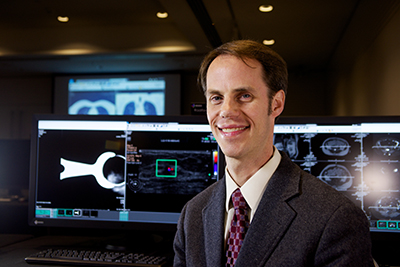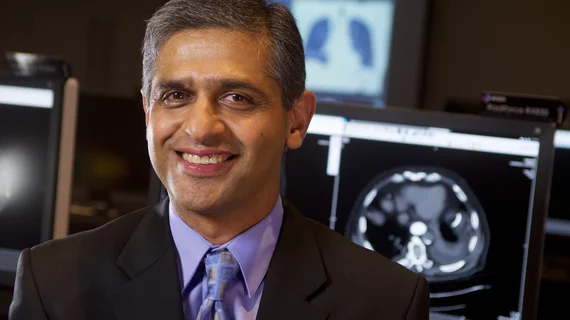The ACR Education Center and Fujifilm’s Synapse: A Powerful Pairing for Training Radiologists
When the American College of Radiology (ACR) opened the ACR Education Center in Reston, Virginia, back in 2008, it was with a very specific goal in mind—to provide radiologists with thorough, hands-on training they can then take home and use in their daily practice.
“The ACR wanted to get away from a passive learning environment and move toward a more active, simulation learning environment,” says Vinay Sandhir, director of the ACR Education Center. “There’s no better way to teach radiologists about what they do than actually going through cases. That was the genesis of everything.”
Ten years later, more than 13,000 physicians have walked through the doors of the ACR Education Center to take one of its many three-day courses. One constant over that decade has been the center’s reliance on Fujifilm’s Synapse PACS.
“Before the center opened, physician and IT leadership from within the ACR vetted prospective vendors and chose Fujifilm,” Sandhir says. “And in the last decade, none of us have ever felt any need to reconsider that decision. We haven’t even thought about moving to a different vendor, because we’re so happy with Synapse.”

Easy to use, easy to learn
The ACR knew it needed a PACS that radiologists could adapt to quickly. If the system was unreliable or confusing in any way, it would be hard for the class to get much done. The students can’t be fighting to keep up—they need to be confident enough with the PACS that they can settle in and focus on the task at hand.
“If the PACS they were training on was too hard to use, the students would feel like things were too difficult,” says Jeffrey Kanne, MD, a longtime instructor at the ACR Education Center. “It could potentially take away from their enjoyment and from the overall experience. However, students are always happy with Synapse because it’s so straightforward.”
Kanne, who is also chief of thoracic imaging and vice chair of quality at the University of Wisconsin-Madison, has taught the center’s “High-Resolution CT of the Chest” course since 2012. He says he knows for a fact that radiologists can pick up Synapse quickly—because he had to do it himself when he first became an instructor.
“The Education Center was actually my first exposure to Synapse,” Kanne says. “But it was easy to learn, and I also noticed that my students picked it up really quickly. Instead of asking a lot of questions about how to use it, they were focusing on the cases themselves. That’s really important when you only have them in there for three days total—there’s not a lot of time to sit around working out tiny issues with the system.”
Kanne adds he works with a mix of students—“some are younger and tech-savvy, some are older radiologists hoping to learn new skills”—and everyone reacts positively to sitting down and working with the system. After testing it out with just one or two cases, all students can perform such tasks as navigating a case, selecting a new case and modifying how images appear on their screen on their own.
Early on, the center would bring in trainees the night before class officially started to give them a head start on how to use the equipment. They quickly realized, however, that the session simply was not necessary. Why require more physician time, they asked themselves, when the system is so intuitive?
“People got the hang of Synapse so fast that we just canceled that extra session altogether,” Sandhir says. “And that led to more people showing up, because now they don’t have to fly in earlier the day before and it just made the courses much more convenient.”
Dependable performance
A large majority of courses offered at the ACR Education Center revolve around clinical interpretation, meaning 50 to 60 trainees need to sit in the same room and access the same PACS at the same time. It may sound like a logistical nightmare—the kind that keeps IT specialists up at night—but the center says it has been more like a dream come true. Students are always able to open Synapse quickly and run it with no issues, no matter how many others are using it.
Sandhir adds that Fujifilm does provide around-the-clock service for any problems that may come up—but they rarely do need help, unless it’s some sort of complex logistical issue they can’t solve internally.
“We have 24-hour support, and we love having it, but I can say that we have never needed Fujifilm’s support for failures that take place during a course,” he says. “It has never, in all these years, been an issue.”
On its way: Synapse version 5
As happy as the ACR is with Synapse, Sandhir notes that things are about to get even better. The ACR Education Center is preparing to upgrade its equipment to Synapse version 5, which Fujifilm designed with high speeds and smart, efficient enterprise imaging in mind.
“Version 5 is going to make things easier,” Sandhir says. “From what I have seen with version 5, I am amazed at the seamlessness of its functionality and its incorporation of digital breast tomosynthesis as well as other advanced imaging functions. Using this latest update is going to be incredibly helpful for all of us at the ACR, and I can’t wait to get it installed in our environment.”
Another big change that comes with the move to version 5 is the possibility that students will be able to continue looking at cases from the comfort of home.
“Previous versions of Synapse required local study caching and they weren’t browser-agnostic, but this latest version different,” he says. “We’ll have the capability to be able to offer continued training to users once they get back home from taking our course. We’re all really excited about that.”
The students approve—and some come back for more
Kanne has nothing but positive things to say about his experience with the ACR Education Center, noting that it’s been a thrill seeing how students can learn so much over the course of just three days. One of his absolute favorite things about this experience, he says, is when he learns just how much of an impact the center has had on his students.
“I often encounter former students years after they take my course, and they all say they became better, more engaged radiologists as a result of everything they learned,” Kanne says. “Some of them say they want to come back to learn even more.”
Sandhir adds that he has heard nothing but glowing reviews from the center’s former students. And there’s one comment he hears again and again. “They say they have never used an easier PACS system”, he says smiling.

